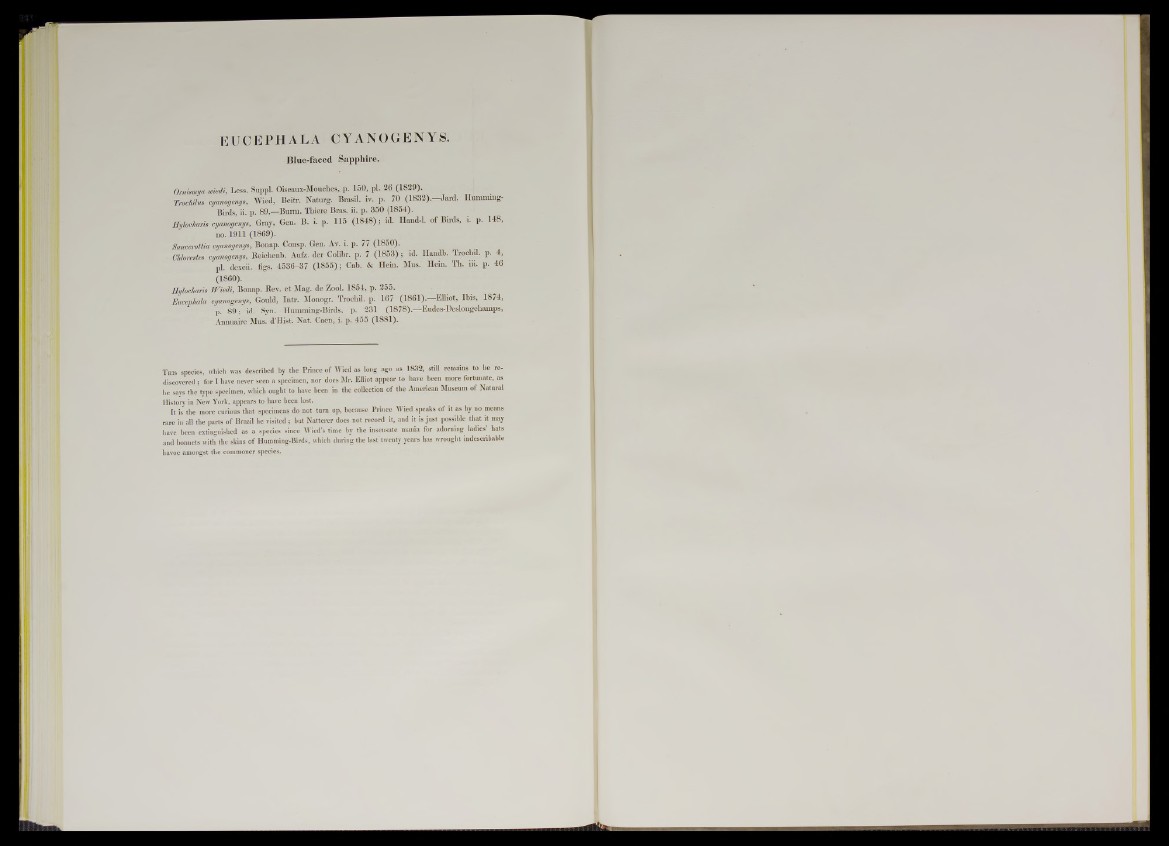
EUCEPHALA CYANOGENYS.
Blue-faced Sapphire.
Ornismya wiedi, Less. Suppl. Oiseaux-Mouches, p. 1 5 0 , pl. 2 6 (1 8 2 9 ).
Trochilus eyanoyenys, Wied , Beitr. Naturg. Brasil, iv . p. 7 0 (1 8 3 2 ) .— Jard. H umming-
Birds, ii. p. 8 9 .— Burm. Thiere Bras. ii. p. 3 5 0 (1 8 5 4 ).
Hylocharis eyanoyenys, Gray, Gen. B . i. p. 1 1 5 ( 1 8 4 8 ) ; id. Hand-1, o f Birds, i. p. 1 4 8 ,
no. 1 9 1 1 (1 8 6 9 ).
Saucerotiia eyanoyenys, Bonap. Consp. Gen. Av . i. p. 7 7 (1 8 5 0 ).
Chlorestes cyanoyenys, Keichenb. Aufz. der Colibr. p. 7 ( 1 8 5 3 ) ; id. Handb. Trocbil. p. 4 ,
pl. dcxcii. flgs. 4 5 3 6 - 3 7 ( 1 8 5 5 ) ; Cab. & H ein . Mus. H ein . Tb. iii. p. 4 6
(1 8 6 0 ).
Hylocharis W ie d i, Bonap. B e v . e t Mag. de Zool. 1 8 5 4 , p. 2 5 5 .
Eucephala eyamg enys, Gould, Intr. Monogr. Trochil. p. 1 6 7 ( 1 8 6 1 ) .— E llio t, Ib is, 1 8 7 4 ,
p. 8 9 ; id. Syn. Humming-Birds, p . 2 3 1 ( 1 8 7 8 ) . g llu d c s-Desiongehamps,
Annuaire Mus. d ’Hist. N a t. Caen, i. p. 4 5 5 (1 8 8 1 ).
T h i s species, which was described by the Prince o f Wied as long ago as 1832, still remains to be rediscovered
; for 1 have never seen a specimen, nor does Mr. Elliot appear to have been more fortunate, as
he says the type specimen, which ought to have been in the collection o f the American Museum o f Natural
History in New York, appears to have been lost.
It is the more curious that specimens do not turn up, because Prince Wied speaks o f it as by no means
rare in all the parts o f Brazil he visited | but Natterer does not record it, and it is just possible that it may
have been extinguished as a species since Wied’s time by the insensate mania for adorning ladies hats
and bonnets with the skins o f Humming-Birds, which during the last twenty years has wrought indescribable
havoc amongst the commoner species.